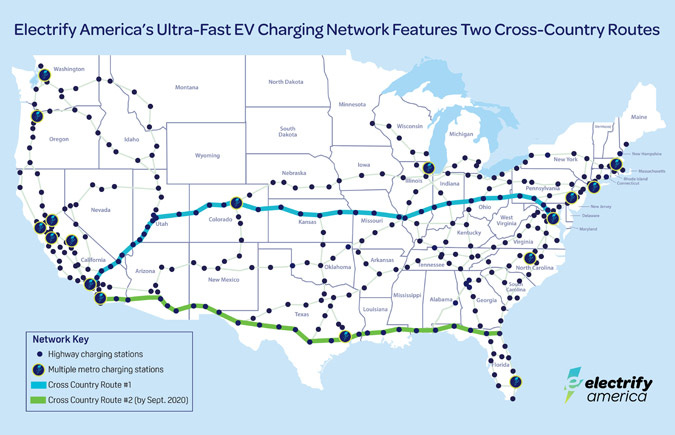Are there Enough DC Fast Charging Stations for non-Tesla Electric Cars?
Plugged In details the state of DC Fast charing stations for non-Tesla drivers in North America. Also included in this issue is Plugged In’s EV glossary.
Image Caption | Electrify America announced the completion of its first cross-country DC fast charging route across the U.S. (above), while Tesla has Superchargers in all states in the lower 48.
Recently, the EV world celebrated a milestone for charging infrastructure back in June when Tesla finished installing the last of four charging stations in North Dakota. With Tesla’s installation in North Dakota, the automaker now has Superchargers (DC Fast Chargers) in all of the lower 48 states.
For the rest of the DC fast charging world, 3rd party charging companies are also installing stations across North America. In 2019, Electrify America (EA) installed DC Fast Charging stations across the US but cable issues plagued many of the new stations. EA temporarily shut down these charging stations for a time in 2019 due to “faulty high-powered cables from Huber+Suhner.”

However, EA bounced back and announced a DC fast charging cross country route across the US; and EA opened up its 400th public charging station earlier in 2020.
The total number of “charging points or connectors” is more than 1,700, with many located near the interstate at big box stores.
This is notable milestone since DC fast charging stations, depending on your state of charge (SoC) and power from the unit, will provide approximately 100 miles of range, anywhere from 15 to 30 minutes — see below our EV glossary.
Plugged In Glossary
State of Charge | This is a measurement of the amount of electricity left in an electric car's battery pack, which is usually represented in percentage terms.
DC Fast Charging | A method of charging available for all electric cars (not PHEVs), where a large amount of Direct Current (DC) electricity is delivered directly by a charging station to the car's battery pack. Measured in kW, some Tesla vehicles can receive up to 75 miles in 5 min, while many other 50kW stations can add 100 miles in approximately 30 minutes.
Level 2 Charging (208 to 240V) | The charging type adds 17 to 55 miles of range per hour while using a 208 to 240V electrical source to power EVSE equipment or directly from an outlet. This type of charging can be found in the home or at public locations, and most Level 2 charging equipment is rated for outdoor/indoor use. But please check with your supplier before purchasing.
Are there other charging networks?
Even though COVID-19 has wreaked havoc on the economy in 2020, 3rd party charging networks like ChargePoint, EVgo, Blink Charging and EA are expanding build out of new stations and finding new automotive partners. EVgo just partnered with General Motors to add more than 2,700 fast charging connections throughout the U.S. over the next five years, with many being located near large retail stores in metro areas. These new DC fast charging stations will be available to customers starting in 2021.
EVgo has installed charging stations at more than 800 locations over the last 10 years, including DC fast charging and Level 2 stations.
Plus, a mix of Level 2 and DC fast charging stations were announced by the Michigan Dept. of Environment, Great Lakes, and Energy (EGLE) in early August. The program found public and private financing, and will add 36 DC fast charging stations along well-traveled routes in the state. This public/private agreement draws money from the VW dieselgate emissions settlement. VW was found guilty of rigging its software and producing emissions 40 times above the legal limit for its clean diesel engines.
Are there charging deserts for non-Tesla EVs?
Yes.
In the summer of 2019, a newspaper article detailed how a Chevy Bolt driver couldn’t travel across Michigan in a day due to the lack of DC fast charging stations. The Bolt driver proceeded to leave Detroit and visit family in Frankfort, MI, on the west side of the state. The problem was the lack of DC fast charging on major interstates in Michigan, and having to endure Level 2 charging.
Fast forward to 2020, ChargePoint and EA added two new DC fast charging stations in central Michigan. Now, this Chevy Bolt trip could made in 7 hours, see image above.
Plus, many Level 2 charging stations are positioned across Michigan that can deliver 17 to 30 miles if the stops are longer than 45 minutes, such as a dinner break or watching your son’s wrestling meet.
While Level 2 charging stations are still being added by some charging network and utilities, the focus is on DC fast charging stations going forward.


The two takeaways for possible non-Tesla drivers are bigger battery packs keep coming, which reduces the number of fast charging stops. For example, Rivian is coming out with 400 mile truck in 2021, and legacy automotive companies are racing to find their niche and support charging initiatives.
This just in | CHAdeMO is a charging standard —CCS, & Tesla’ Superchargers are the others— that is backed by Nissan. Nissan led the automotive industry with its release of the Leaf in 2010. Now the CHAdeMO standard is going away with the new 2021 Nissan Ariya car and Nissan is now moving to the CCS charging standard.
Currently, Electrify America’s DC Fast Charging stations across the country come with three CCS chargers for every 1 CHAdeMO charger and that won’t be changing any time soon as VW, Hyundai and Ford, among others, are tied to this standard.
Charging Spotlight | Grand Rapids, Michigan
Hot Take | The Grand River runs through this quintessential midwestern city in Michigan. It’s home to a solid EV charging infrastructure with more than 235 charging stations in the city and allows for EV drivers to charge at hotels, public parking structure or ice arenas.





